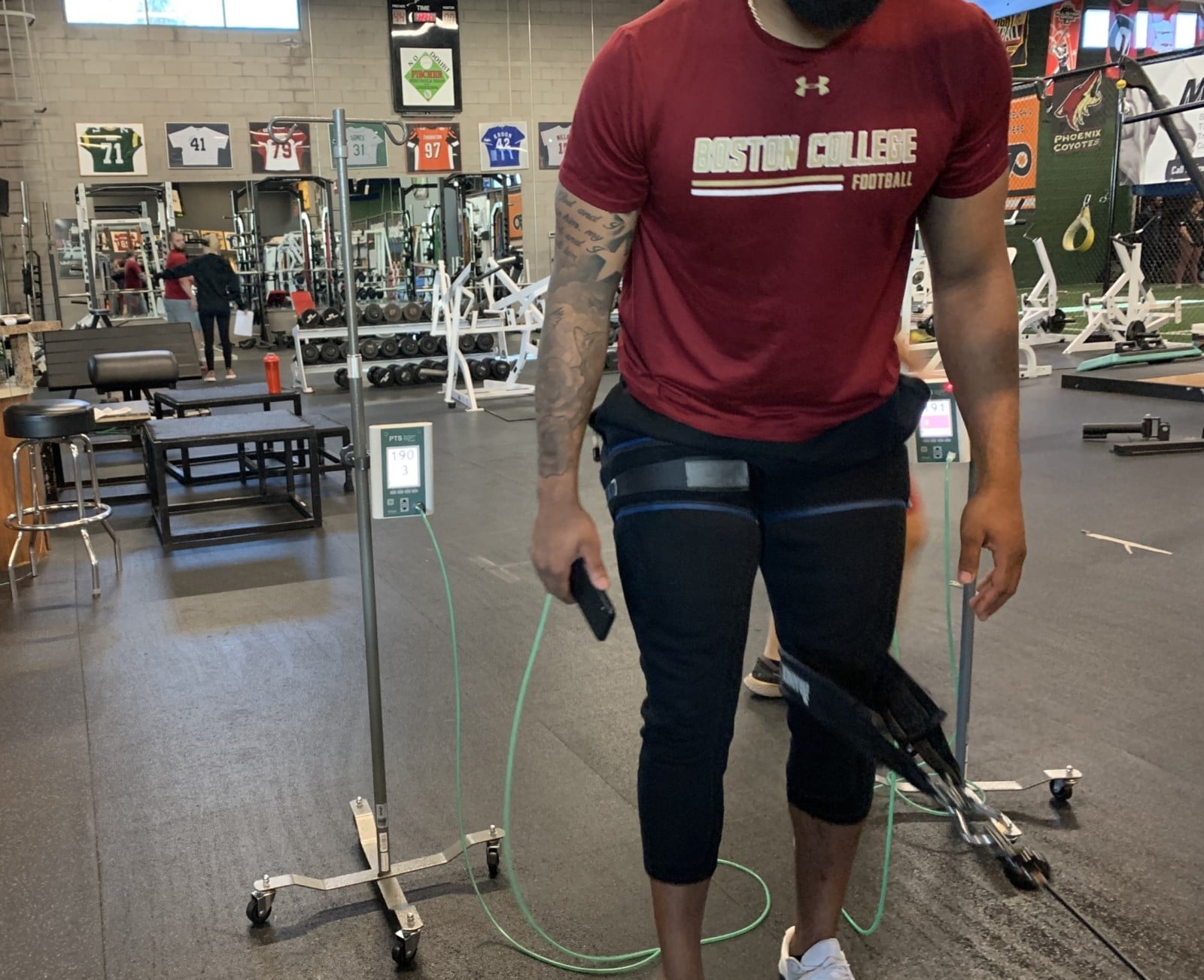Blood flow restriction (BFR) therapy, also known as blood flow restriction training, is a relatively new method of injury recovery therapy that promises dramatic results. But what exactly is it, when is it used, and is it safe?
We asked Brett Fischer, PT, ATC, CSCS, DN, Cert. Astym founder of the Fischer Institute of Physical Therapy & Performance (a division of Spooner Physical Therapy) to give us the lowdown on BFR.
What Is BFR Therapy?
In BFR, a physical therapist applies a specialized surgical tourniquet system to your arm or leg, and inflates the tourniquet to a specific pressure (which is personalized to you) to reduce or cut off blood flow to that extremity.
Your PT will leave the tourniquet on for about 6 minutes (again, the exact duration is personalized). During that time, you’ll use a “super low weight” to exercise the muscles that are being deprived of blood. Because blood flow to the muscle is restricted, your brain is essentially tricked into thinking the muscle is lifting a much heavier weight or exercising much harder than it actually is.
The result? Big gains for a muscle that otherwise can’t support heavy training.
Those Gains Sound Nice, But Is BFR Painful?
“It feels like you’re getting your blood pressure taken,” explains Fischer. “And you can expect to feel like you’re working out.”
He says that’s one of the things that surprises patients most: That despite the low weight, they actually feel the muscle working to fatigue. Athletes who are accustomed to lifting heavier weight “always roll their eyes at the low weight. And usually at the end of that first five minutes they say it felt like they did a million repetitions. Then they say, ‘Oh, I get it now. I understand’,” Fischer says.
Who Thought of BFR?
BFR training as it’s used today has its origins in the military. “These military service members were getting blown by landmines, and the shrapnel was causing multiple fractures to legs and body parts, tearing their muscles apart. They would later wind up amputating an extremity because they couldn’t save it,” Fischer explains.
Johnny Owens is a PT who introduced BFR to the army, with a goal of salvaging and rehabbing the limbs of these wounded warriors. He’s developed a certification for BFR that Fischer says is the elite certification due to its emphasis on safety. Through Owens work, safe practice of the therapy has been made widely available to all kinds of patients.
Are There Any Risks?
BFR has been proven safe in multiple studies, but Fischer cautions that its safety depends on who administers the therapy and whether or not they’re certified and using the right equipment. Even though BFR is popping up in fitness studios and spas, it’s important to find a certified provider who is a physical therapist.
A certified provider will use the pneumatic tourniquet system that is classified and regulated as Class 1 by the FDA, and that is specifically intended for BFR. Fischer uses a Delfi PTS system that can only be purchased by certified providers.
These tourniquet systems measure exactly how much pressure is required to restrict blood flow for a specific patient. Fischer says this is called “occlusion pressure,” and your occlusion pressure will be different than that of your mom, your training partner, or the patient next to you. Using an incorrect occlusion pressure could lead to blood clots, nerve or artery damage.
How Can This Help Me As An Athlete?
BFR is common among pro and collegiate athletes, who use it as low-load resistance training to enhance muscle growth as a supplement to high-load training. Fischer uses BFR to help all kinds of athletes, including the Arizona Cardinals (he is the staff PT for the Cards). He says it can help with recovery, flushing out that heavy feeling in the legs after a particularly punishing workout, as well as rehabbing a muscle to prevent atrophy after an injury or surgery.
Is BFR Just For Athletes?
BFR is for anyone who has an injured limb or loss of muscle mass in a limb. “For us in physical therapy, we’re able to take people who have deteriorated to the point that they are bone-on-bone and do things they otherwise couldn’t do to get stronger,” says Fischer.
Some patients shouldn’t use BFR, including those with a history of blood clots, active cancer in the affected area, impaired circulation, sickle cell anemia, and severe hypertension. This is another reason BFR should only be administered by certified PTs in a clinical setting.
Beyond athletes, Fischer says that other good candidates include those with osteoarthritic knees or knee injuries, rotator cuff, shoulder or Achilles tendon injuries, and post-op patients following knee or shoulder injuries. Usually after injury or surgery, the affected muscles can’t tolerate weight bearing or lifting, but BFR can be used early on in recovery, speeding recovery time and limit atrophy.
“That’s the beauty of this. We can make significant gains to the muscles, bones and tendons so much earlier and so much more safely because we’re not using a lot of weight,” Fischer says.
Learn more about Blood Flow Restriction Therapy at Spooner Physical Therapy. Ready to schedule an appointment? Schedule an appointment or complimentary movement screen with a Spooner physical therapist at one of our locations throughout the valley.

